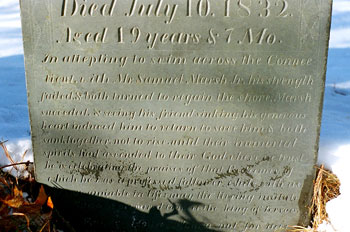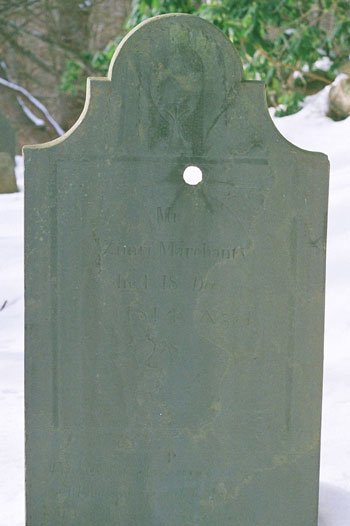Slate Facebook

The finely carved and uniform lettering of this 1832 slate gravestone is exceptional. The thick stone remains in good condition. It would have been a considerable expense for a family in this rural town. It reads: “Phineus Hosmer, died July 10th, 1832. Aged 19 years & 7 Mo. In attempting to swim across the Connecticut River with Mr. Samuel Marsh Jr., his strength failed and both turned to the shore. Marsh succeeded & seeing his friend sinking, his generous heart induced him to return to save him & both sunk together not to rise, until their immortal spirits had ascended to their God, where we trust he is celebrating the praises of the redeemer, of which he was a professional follower while he was with us. He was amiable in life, may the living imitate his virtues, be prepared to meet the king of terrors.” Photo courtesy of W.E. Oldham
Some of this country’s oldest gravestones are in New England’s old port cities. For the most part ignored today, some early gravestone epitaphs can in a few lines describe the respect for an elder or the tragic loss of one too young to have died. In the days before newspaper obituaries, or newspapers for that matter, epitaphs could serve as a stone Facebook.
The Eastern Burial Ground at the foot of Munjoy Hill in Portland, Maine was chartered in 1668. This date marks the official establishment of the cemetery, but not necessarily the first burial. Cemeteries are the municipal grounds and graveyards a church’s burial ground. One of the first things done in any settlement was locating a place for the inevitable dead bodies. Early settlers buried in Portland included several victims of Indian attacks in1689. There are underground tombs there, each with as many as sixty bodies, Quaker and African American sections as well as the grave of the city’s first bank robber, Daniel Manly who died in 1818.
But it is the large number of epitaphs of those whose lives ended at sea and those who died far from their Maine home, which stand out in coastal Maine burial grounds. “Lost at sea”, “In foreign climes alas resigns his breath”, “Executed for murder on the high seas”, “I lost my life in the raging seas”, and “Killed by a fall from the masthead” are a few brief versions of maritime epitaphs.

The image of a stylised angel was very common in the 17th and 18th centuries. The lettering layout lines are still visible some 230 years later. The lettering style and abbreviated words are more common to the 1600’s and 1700’s. Experience may have been the sister-in-law of Enoch who passed 8 months earlier. Photo courtesy of W.E. Oldham
The two most noted Portland graves might be those of US Navy Captain William Burrows and British Navy Captain Samuel Blyth. Both died in a naval battle during the War of 1812 off Pemiquid Point. Visible from Portland, a crowd gathered to watch the two ships blast each other apart on September 5, 1813 and later to see the double funeral procession for the young captains to the Eastern Burial Ground.
Another famous and strange, in a New England way, stone is at the Buck grave in Bucksport. Maine. Gen. Jonathan Buck tried, convicted and sentenced to death his mistress who he claimed was a witch. She declared she would dance on the General’s grave. To this day there is a stain in the shape of a leg on his 1824 gravestone that has resisted repeated attempts to remove it. The witch’s leg is visible from Route 1, one block east of the Verona Island bridge.
The belief in, fear and execution of witches is a well known aspect of life in early New England. More often associated with Salem, MA, this transplanted European mania rooted in a power struggle over medical care and an ongoing battle for religious authority surfaced by convenience. Comments, appearance or the right accuser were enough for a conviction. Mentioning thoughts about air travel or an internet would have gotten you roasted and buried face down faster than you could have said “just kidding” in 17th century New England.
Some of the oldest gravestones are in Boston, but many nearly as old are more than 100 miles west of Boston in towns along the Connecticut River. It didn’t take long for early settlers to learn of the rich river bottom cropland farmed by native Americans in the Connecticut River Valley. The towns of Deerfield, Montague, Hatfield and others were established at the head of the widest area of bottomland just south of the Vermont border.

Slate stone in a remote grown over and now wooded private family graveyard near the Connecticut River. The family was among the first Europeans to settle there and among the few to survive the Indian wars of 1675 and 1704. A plain stone with images of an urn and willows, the bullet hole is presumed to be not part of the original design. The hole seems likely to have been made by musket ball, as a rifle cartridge would have made a smaller hole. Mr. Marchant who died in 1814, during another war at 98 years, would have been born not long after the most famous French and Indian raid on Deerfield, MA in 1704. Photo courtesy of W.E. Oldham
Early gravestones were often black slate. Slate carved well and lasted. The majority of stones had symbolic ornamentation and a simple statement. But from the earliest colonial days hundreds of common burial stone symbols told stories familiar to many in a world where literacy was not universal - an arch meant victory in death; corn a ripe old age; an urn represented immortality, a face or skull with angelic wings the deceased soul flying to heaven, etc. Some stones combined elaborate symbols with the text. That text could be brief, a poem, personal comments about the deceased, a religious or philosophical phrase on life and death.
The decorative symbols are interesting, but the written text in some old epitaphs are what link the people of the 17th century to us in the 21st century. The grief from the loss of a child in a swimming accident, or to fever, or to some other tragedy remains alive in epitaphs. That connection seems lost when reported by a third party in an old newspaper or by an historian.
The quality of the craftsmanship in the carving of symbols and text varied. The phrasing can be exceptionally direct and almost contemporary compared to other formal and stiff writing from the same period.
Some stone carvers followed the instructions for the text given them, but were themselves not literate. Spelling was not as uniform as it is today. Various abbreviations were used, and a lapse of attention might mean having to add a skipped word above a line of text. There was no erasing of errors on what could be an expensive piece of black slate. A stone at all in the 18th century was for those of some means.

The third stone in the same rural Connecticut Valley cemetery. It has another unusually long epitaph. It too describes a tragic end and loss for the family. The loss in part measured by the near permanence of the message for succeeding generations. It reads: “In memory of Mr. Elijah Bordwell who died Janry 26th in ye 27th year of his age having but a few days survived ye fatal night when he was flung from his horse and drawn by ye stirrup 26 rods along ye path as appeared by ye place where his hat was found and where he had spent ye whole night treading ye snow in a small circle. The family he left was an aged father, a wife and 3 small children. On this side death mans dangers never cease. Beyond ye virtuous share eternal peace.” Photo courtesy of W.E. Oldham
It is what some stones reveal about the individual who died, about the views of life, death and tragedy as well as humor in the face of the loss of someone dear that make them unique historical and social records.
One stone in the Connecticut River of Montague is inscribed with the grim story of a man who was dragged by his horse.
Some of these deaths predate newspapers and their obituary columns. The words of lives or tragic deaths, carved in stones permanently placed, go beyond the fleeting presence of newsprint. They connect people of today with people 350 years ago, revealing human likenesses few other things seem able.
As startling as the tragic epitaphs can be, the flip side of the dark is the light and humorous epitaphs can be startlingly funny given the context. Common too are stories and myths associated with some gravestones. In Wiscasset, Maine one Moses Carleton made a fortune in the 18th century sea trade. One day it is said he removed a gold ring from his finger and threw it in the Kennebec River. It is rumored that he said, “I am about as likely to see that ring again as I am of dying a poor man.” A few years later he sat down to a fish dinner and that same ring was found in his fish. And by the time he had died he had lost his fortune.
